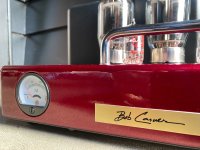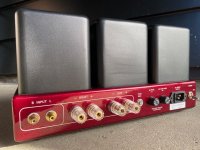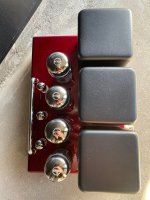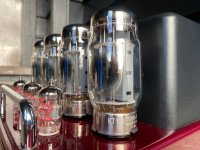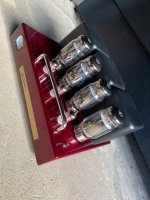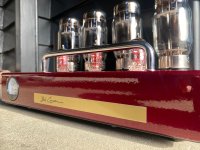Hi, members of the Forum with much wisdom.
There is a Carver amp for sale close to where I live. The description is below. My question is.. are the claims made in this advertisement for real? If so, how would this work? Has anyone got a circuit diagram?
If these claims are real, surely someone would have copied, adapted or improved these features.
Your thoughts?
Crimson 275 uses KT120 output Tubes that run thru Bobs unique DC restorer circuit. This allows the tubes to run cool and extend the life of the tube. The variable bias circuit allows you to fine tune the sonic signature and make the amp sound warmer like a classic tube amp or add detail like a more contemporary design. Set from the factory the 275 sounds amazingly close to the large 350 watt mono’s but with only 1/4 of their power and is about 30% of their cost.
Bob’s unique DC Restorer circuit makes the amp much more efficient than conventional allowing the use of hi efficient smaller output transformers. Advantages are that it runs cooler than normal tube amps, weighs less and the tubes should last forever.
Another significant feature of Bob’s design is its ability to “ listen to the room,” sometimes referred to as the speaker-microphone effect,’
Facilitated by a special current feedback loop, it allows the amplifier to hear’ the room’s reverb, along with its unique sonic signature. Each room plays its own tune, and this amp uses the speaker as a microphone by using the speaker in reverse (the theorem of reciprocity) to “listen to the room,’ thereby allowing a portion of the room acoustic to be expressed through the main speakers. Think of it this way, the room becomes an integral part of the music in a way no other amplifier allows. The sound is more majestic, more realistic, and the soundstage is larger and more compelling than it would be without this unique ability. (sells in the USA $2,750.00 + State Tax)
Specification:
Rated Power: 75 watts / 8 ohms or 4 ohms
Distortion: less than 0.5%
Line inputs: 2 x RCA
Input Impedance: 100 kohms
Gain: 30 dB (8 ohms)
Tube Complement: 1 x 12AX7, 2 x 127AT7, 4 x KT120
Bias: Rear panel potentiometer adjust, front panel metre
Source Impedance: 1.7 ohms

There is a Carver amp for sale close to where I live. The description is below. My question is.. are the claims made in this advertisement for real? If so, how would this work? Has anyone got a circuit diagram?
If these claims are real, surely someone would have copied, adapted or improved these features.
Your thoughts?
Crimson 275 uses KT120 output Tubes that run thru Bobs unique DC restorer circuit. This allows the tubes to run cool and extend the life of the tube. The variable bias circuit allows you to fine tune the sonic signature and make the amp sound warmer like a classic tube amp or add detail like a more contemporary design. Set from the factory the 275 sounds amazingly close to the large 350 watt mono’s but with only 1/4 of their power and is about 30% of their cost.
Bob’s unique DC Restorer circuit makes the amp much more efficient than conventional allowing the use of hi efficient smaller output transformers. Advantages are that it runs cooler than normal tube amps, weighs less and the tubes should last forever.
Another significant feature of Bob’s design is its ability to “ listen to the room,” sometimes referred to as the speaker-microphone effect,’
Facilitated by a special current feedback loop, it allows the amplifier to hear’ the room’s reverb, along with its unique sonic signature. Each room plays its own tune, and this amp uses the speaker as a microphone by using the speaker in reverse (the theorem of reciprocity) to “listen to the room,’ thereby allowing a portion of the room acoustic to be expressed through the main speakers. Think of it this way, the room becomes an integral part of the music in a way no other amplifier allows. The sound is more majestic, more realistic, and the soundstage is larger and more compelling than it would be without this unique ability. (sells in the USA $2,750.00 + State Tax)
Specification:
Rated Power: 75 watts / 8 ohms or 4 ohms
Distortion: less than 0.5%
Line inputs: 2 x RCA
Input Impedance: 100 kohms
Gain: 30 dB (8 ohms)
Tube Complement: 1 x 12AX7, 2 x 127AT7, 4 x KT120
Bias: Rear panel potentiometer adjust, front panel metre
Source Impedance: 1.7 ohms
Attachments
It sounds like running in cool class-AB, which ordinarily can lead to crossover distortion due to bias excursion. The DC restorer is probably a clamping circuit that stop the bias from drifting too cold. There are threads about this sort of thing on this forum.
The amp is also using a small amount of current feedback, and he is claiming that if a room reverbation pushes back on the cone, the current feedback will sense it and try to correct for it, or "be expressed through the main speakers" whatever that means. Basically it's marketing, as usual.
The amp is also using a small amount of current feedback, and he is claiming that if a room reverbation pushes back on the cone, the current feedback will sense it and try to correct for it, or "be expressed through the main speakers" whatever that means. Basically it's marketing, as usual.
Last edited:
audiosciencereview tested this and found it was a scam in every detail :
https://www.audiosciencereview.com/forum/index.php?threads/carver-crimson-275-review-tube-amp.29971/
https://www.audiosciencereview.com/forum/index.php?threads/carver-crimson-275-review-tube-amp.29971/
If the amp is sold for 3K bucks, you buy parts of about max. 500 bucks.
What costs a KT120 tube by the way?
What costs a KT120 tube by the way?
THD is usually specified at a certain frequency & power OP.Distortion: less than 0.5%
Current FB is applied to make the amp stable with difficult loads at very high frequencies AFAIK.
Andy.
Steaming pile of marketing. Clean up on Aisle 'Bob' needed.
Douglas
Douglas
The DC Restorer is supposed to prevent "blocking" distortion from max input signals by preventing charge build up on the grid input caps (to the output tubes ).
With that DC Restorer implemented, one -could- lower the output tube bias currents some for cooler output tube operation while not cutting out. That however would increase "zero crossing" or "crossover" distortion (in class AB P-P ), so not very attractive. The DC Restorer is still useful, but not a new miracle.
With an output Z of 1.7 Ohms, the damping factor is lowish, which is what current Fdbk does. Some old tube Amps used this feature to achieve "critical damping", so that speaker resonances could be damped out by the matched driving resistance (or driving impedance). Not often done anymore and needs to be "tuned" to the particular speaker. These older Amps had an adjustment knob on the back. Some speaker drivers or crossovers may be designed as critically damped already.
With that DC Restorer implemented, one -could- lower the output tube bias currents some for cooler output tube operation while not cutting out. That however would increase "zero crossing" or "crossover" distortion (in class AB P-P ), so not very attractive. The DC Restorer is still useful, but not a new miracle.
With an output Z of 1.7 Ohms, the damping factor is lowish, which is what current Fdbk does. Some old tube Amps used this feature to achieve "critical damping", so that speaker resonances could be damped out by the matched driving resistance (or driving impedance). Not often done anymore and needs to be "tuned" to the particular speaker. These older Amps had an adjustment knob on the back. Some speaker drivers or crossovers may be designed as critically damped already.
Last edited:
I simulated DC restorer in LTSpice with THD analysis, Its not a miracle which will allows to reduce bias current almost to zero. 60mA to 45mA still be good, however.
- Home
- Amplifiers
- Tubes / Valves
- Is this description of a Carver tube amp for real?
